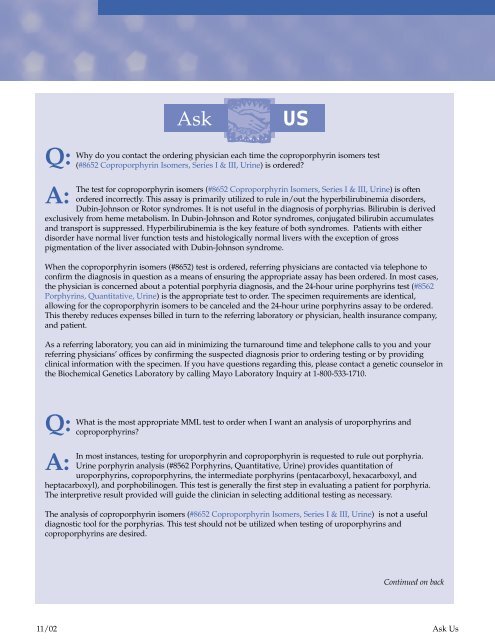The Challenges Of Testing For And Diagnosing Porphyrias
The Challenges Of Testing For And Diagnosing Porphyrias
The Challenges Of Testing For And Diagnosing Porphyrias
You also want an ePaper? Increase the reach of your titles
YUMPU automatically turns print PDFs into web optimized ePapers that Google loves.
Q:<br />
A:<br />
Ask<br />
(<br />
US<br />
Why do you contact the ordering physician each time the coproporphyrin isomers test<br />
(#8652 Coproporphyrin Isomers, Series I & III, Urine) is ordered?<br />
<strong>The</strong> test for coproporphyrin isomers (#8652 Coproporphyrin Isomers, Series I & III, Urine) is often<br />
ordered incorrectly. This assay is primarily utilized to rule in/out the hyperbilirubinemia disorders,<br />
Dubin-Johnson or Rotor syndromes. It is not useful in the diagnosis of porphyrias. Bilirubin is derived<br />
exclusively from heme metabolism. In Dubin-Johnson and Rotor syndromes, conjugated bilirubin accumulates<br />
and transport is suppressed. Hyperbilirubinemia is the key feature of both syndromes. Patients with either<br />
disorder have normal liver function tests and histologically normal livers with the exception of gross<br />
pigmentation of the liver associated with Dubin-Johnson syndrome.<br />
When the coproporphyrin isomers (#8652) test is ordered, referring physicians are contacted via telephone to<br />
confirm the diagnosis in question as a means of ensuring the appropriate assay has been ordered. In most cases,<br />
the physician is concerned about a potential porphyria diagnosis, and the 24-hour urine porphyrins test (#8562<br />
Porphyrins, Quantitative, Urine) is the appropriate test to order. <strong>The</strong> specimen requirements are identical,<br />
allowing for the coproporphyrin isomers to be canceled and the 24-hour urine porphyrins assay to be ordered.<br />
This thereby reduces expenses billed in turn to the referring laboratory or physician, health insurance company,<br />
and patient.<br />
As a referring laboratory, you can aid in minimizing the turnaround time and telephone calls to you and your<br />
referring physicians’ offices by confirming the suspected diagnosis prior to ordering testing or by providing<br />
clinical information with the specimen. If you have questions regarding this, please contact a genetic counselor in<br />
the Biochemical Genetics Laboratory by calling Mayo Laboratory Inquiry at 1-800-533-1710.<br />
Q:<br />
A:<br />
What is the most appropriate MML test to order when I want an analysis of uroporphyrins and<br />
coproporphyrins?<br />
In most instances, testing for uroporphyrin and coproporphyrin is requested to rule out porphyria.<br />
Urine porphyrin analysis (#8562 Porphyrins, Quantitative, Urine) provides quantitation of<br />
uroporphyrins, coproporphyrins, the intermediate porphyrins (pentacarboxyl, hexacarboxyl, and<br />
heptacarboxyl), and porphobilinogen. This test is generally the first step in evaluating a patient for porphyria.<br />
<strong>The</strong> interpretive result provided will guide the clinician in selecting additional testing as necessary.<br />
<strong>The</strong> analysis of coproporphyrin isomers (#8652 Coproporphyrin Isomers, Series I & III, Urine) is not a useful<br />
diagnostic tool for the porphyrias. This test should not be utilized when testing of uroporphyrins and<br />
coproporphyrins are desired.<br />
Continued on back<br />
11/02 Ask Us

















